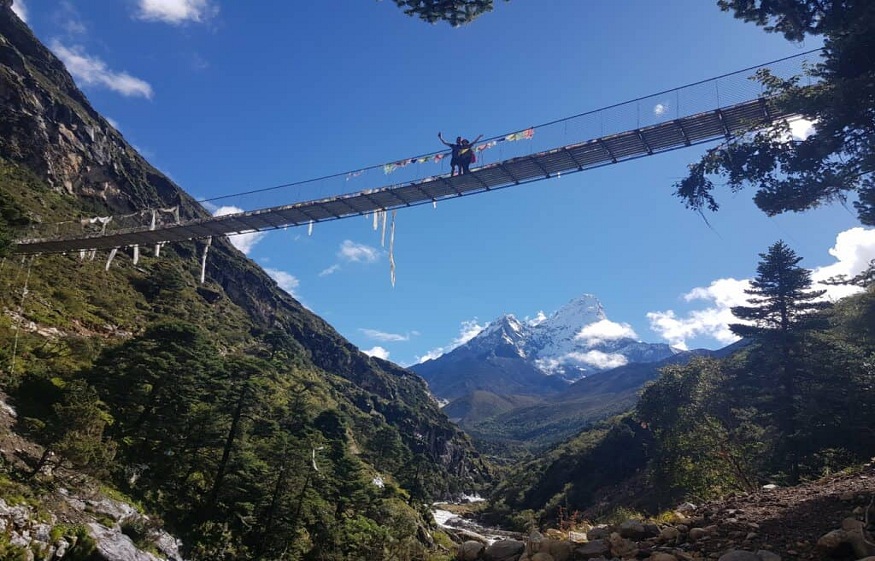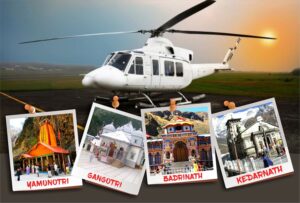How to Trek Everest Base Camp in 7 Days: A Shortened Itinerary

Reaching Everest Base Camp (EBC) in 7 days is an ambitious but achievable target for experienced trekkers or those with a high level of fitness endurance. The trek generally takes a longer duration of 12 to 14 days to fully acclimatise to avoid altitude sickness. However, a shortened 7-day itinerary requires quick ascents and is only for those in good physical condition.
Himalayan Base Camp Trek Physical fitness is one of the crucial factors that will make it easier for you to complete the trek in a shorter time. The Everest region has steep and aggressive terrain that requires the kind of excellent cardiovascular health, stamina, and leg strength that you need to take it on. Before you take to the trails, it is important to build endurance through a combination of hiking, cardio workouts, and strength training. In addition, routinely hiking at higher altitudes can acclimate your body to the thinner air of trail level.
Another vitally important element of a successful 7-day trek is adequate acclimatization. Having a few rest days might not be possible for you, but you should try to go up slowly and let your body get used to the altitude. You would ideally use “climb high, sleep low” techniques — hiking higher during the day but sleeping at a lower elevation. This will reduce the risk of altitude sickness.
Staying hydrated and fed are key, too. Staying hydrated and eating calorie-dense foods will fuel you through long days of trekking. The teahouses along the route provide well-balanced meals, while nuts, dried fruits, and energy bars come in handy during the hike.
So, timing your trek is equally critical. The best trekking seasons to the Everest base camp are spring (March to May) and autumn (September to November). The weather is generally stable and offers clear views of the mountains. Don’t trek during the monsoon season as trails could be slippery and dangerous.
Though with a limited time frame, packing a light bag is a must for the trek. You must choose your equipment wisely, ensuring that you possess only the essentials for a safe and pleasant hike. Buy good quality clothes adapted to the weather conditions, good quality sleeping bags, a waterproof coat, trekking boots, and a comfortable bag.
Lastly, mental readiness is crucial. The trek, which takes 7 days minimum, is strenuous and can be exhausting, especially on the longer days. Mental grit will help carry you through fatigue and keep you focused on achieving the goal. Expect painful moments, but keep in mind that the view of Mount Everest from the summit will be worth every step you take.
To summarise, it is indeed possible for fit and experienced trekkers to reach Everest Base Camp in only 7 days, but it necessitates absolute preparation, physical fitness, and a highly cautious approach to acclimatisation. Be prepared to face the challenges of the Everest region, prioritizing your health and well-being.
Is it Possible to do a 7-day Trek to EBC?
This 7-day trek to Everest Base Camps (EBC) is a very ambitious and demanding goal, but it is manageable if you are an experienced trekker or if you have athletic abilities. This is usually done in 12-14 days, with rest days for acclimatization. However, if you would like to shorten the trip to 7 days, you will need to be in good shape and have a good level of fitness, and you will also need to be more cautious of the risk of altitude sickness. With a steady pace, no days off, and knowing how to control your body’s reaction to changing altitude, it can be done in 7 days. Although this abbreviated itinerary can provide a more concentrated experience, know that acclimatization will be restricted, raising the chances of altitude sickness. Preparation — both physical and mental — is critical to success, as is understanding your limits as you endure this more condensed version of the classic EBC trek.
Training Syllabus and Acclimatization
One of the key factors for the successful and safe trek to Everest Base Camp (EBC) is Acclimatization. Lack of oxygen at high altitudes on the trail, particularly above 3,000 meters, risks altitude sickness if your body doesn’t have time to acclimatize to lower oxygen levels. During a normal itinerary, treks gradually ascend over several days with rest days, giving the body time to adjust. But on a 7-day trek, acclimatization time is tremendously short. The corona down-climb zone is to be followed for a while following the rule which states to climb high, sleep low, where you shall have to ascend to a higher point during daytime whilst sleeping atop the descent for body adjustment. It could be tempting to dash to Base Camp in a quicker time, but you should watch for any telltale signs of altitude sickness — headache, dizziness, and nausea — and be prepared to descend right away should any symptoms develop. Before the sudden altitude change, your body must adjust to prevent any severe altitude sickness, which can ruin your trek. So, a 7-day itinerary is indeed doable, but if you go this route, you need to think through acclimatization strategies and be prepared to adjust the plans if you find yourself not coping as well as you expected.
Things to keep in mind on a comparatively shorter trek
A 7-day Everest Base Camp (EBC) trek is a condensed version that demands more training and caution than the traditional 12-14 day EBC trek. Another important factor here is the speed of your ascent; without sufficient acclimatization, altitude sickness can become a very real danger, so even on a fast trek, it’s essential to take it slow. It’s something about the elevation gain, though safe practices of it still apply here, even if the trek is shorter. Another factor is physical demand — trekking at high altitudes for more hours a day can be tiring, especially on back-to-back days. Fitness and stamina are the key, as is knowing your limit. The Everest Region is still one of the most sought-after trekking segments. It offers a gorgeous view of the Himalayas, however, the weather can be unpredictable in the area, so being prepared for inclement weather is crucial, even in the main trekking seasons of spring and autumn. Consider also your mental fortitude — the fast-paced march will test your resolve, so staying focused and committed will set you up for success. Finally, check that you have the correct permits, as trekking without them can lead to significant delays or fines. To take a shortened trek, you need a balance between pushing your boundaries and being safe.
Important Permits for the EBC Trek
All Everest Base Camp Trek Cost requires some important permits for safe and legal access. The two primary permits you will require are the Sagarmatha National Park Permit and the TIMS (Trekkers’ Information Management System) Card. The Sagarmatha National Park Permit allows you access into the park, which includes the EBC region, and also makes sure you are abiding by the government’s rules for trekking within this protected area. The TIMS card is mandatory for all trekkers in Nepal. It collects your details and assists the authorities in tracking your trek in the event of an emergency. They are usually acquired in Kathmandu or Lukla and will be checked throughout your trek at different checkposts. When applying for these permits, ensure you have the required documentation, including your passport and passport-sized photos. If you’re tabbing with a guide or porter, there could also be extra costs for their permits. Keep in mind, these permits are not mere paperwork— they are also part of how environmental and local economic protection efforts are funded. If you’re trekking without the proper permits, you could incur fines or be turned back, so always check that they’re in order before you set out on your trek.
Education and Physical Readiness
This article focuses on how to train for a 7-day trek to Everest Base Camp (EBC). Considering the high altitudes and rugged terrain involved, training your body for the trek is an essential part of making it successful and safe. Begin with endurance—long hikes or runs at a consistent pace will have you ready for days of physical exertion back to back. Cardio fitness is important for high-altitude treks, so biking, swimming, or fast walking will increase your heart and lung training. Add strength training for your legs, core, and upper body to prepare for the steep climbs and variable terrains you’ll face on the trail. Squats, lunges, hill climbing, and other strength-building exercises can help strengthen these muscles, which come in handy while trekking. Most importantly, though, train by doing hikes with a fully loaded backpack to prepare for the weight that you will be carrying, and to get the strength you need to handle the climb. It’s also important to train in different types of terrain, like uphill and rocky paths, as these tend to be common on the EBC trail. Finally, prepare yourself with 2-3 months of consistent training. Keep your training sessions high on both aerobic fitness and strength building while gradually enhancing the intensity of your workouts to simulate the demanding nature of a high-altitude trek.
Classroom: What not to bring on the 7-day trek
What to pack for your 7-day Everest Base Camp (EBC) trek is one of the most important dimensions of comfort, safety, and performance. You need good trekking boots that are broken in and support long, rugged hikes. Load up on weather clothes — layers are the secret to surviving the mountain temperature ranges. It’s best to wear three layers of clothing: a moisture-wicking base layer close to the skin, an insulating mid-layer (such as fleece), and a waterproof, windproof, breathable jacket as the outer layer. The colder nights also require trekking pants and thermal clothing. You’ll need a cold-weather rated sleeping bag, because it can get bone-chillingly cold at higher altitudes. You’ll also need sunscreen, sunglasses, and lip balm to protect you from the harsh sun (bring one of the strong fancy ones), as well as a headlamp for early starts or late arrivals. A low-profile, equally lightweight and durable backpack will allow you to carry your gear conveniently without feeling overloaded. You need a water bottle or hydration system to stay hydrated, and packing snacks such as energy bars and nuts will help you get through long trekking days. Finally, don’t forget first aid essentials, such as medications for altitude sickness (like Diamox) and basic items such as bandages and antiseptic. Packing light but effectively will help you make the most out of your trek.
Dealing With Altitude Sickness on a Tight Timeline
When Trek to Base Camp Mount Everest in a condensed 7-day itinerary, the ability to cope with altitude sickness becomes more critical. Since you won’t have the luxury of plenty of rest days to acclimatize, it’s important to pay attention to your body for possible signs of altitude sickness, like headaches, dizziness, nausea, or fatigue. The trick to evade altitude sickness on a short trek is to climb slowly and take short breaks often to rest and hydrate. It helps a lot on this fast-paced trek to follow the “climb high, sleep low” rule, where you climb higher during the day but descend to sleep at a lower altitude. You do not want to overexert yourself too quickly; understand that your body will require some time to acclimatize to the lower levels of oxygen. If any symptoms of altitude sickness develop, it’s important to descend to a lower altitude immediately and seek medical assistance if necessary. While a drug like Diamox can control the symptoms, it is never a substitute for good acclimatization. Even if you are on a strict timeline, it is crucial to have the flexibility to alter your schedule if necessary.
Plan Your Day: How to Do More in Less Time
Let’s get into how to do the Everest Base Camp trek in 7 days! To do this, you’ll need to plan well and make sure that every day is used to the fullest. Start with crafting an itinerary that keeps you on the trail for as long as possible while reducing long breaks. You’re going to be walking for 6-8 hours daily, so plan for a head start and get in as many daylight hours as you can. Pack light, only packing things that you will need and can get to easily. To avoid unnecessary loops that can eat into your precious time, plan a straightforward itinerary hitting the main attractions, such as the classic Everest Base Camp walk via Lukla. Listen to your body, keep a steady, consistent pace to help improve your efficiency. Take short, regular breaks, especially on steeper bits, to conserve your energy. Drink water and eat food — don’t waste precious time fatigued or dehydrated. Have your gear sorted and ready, as this means no sitting on the trail, nor naked feet on unprepared beaches. When you’re mapping out your accommodations, choose teahouses that offer comfortable lodging, but do not linger for too long at each halt to stay on time. But if you can make full use of every minute and keep your discipline, you can still leverage every second, even with a shorter period.
Trekkers need to remain cautious about health and safety on these rapid 7-day treks to Everest Base Camp. First, familiarize yourself with altitude sickness symptoms that can come on rapidly at high altitudes. Hydration is key — at altitude, dehydration occurs more quickly, and you should be drinking water regularly throughout the day. And be sure to eat balanced meals, especially those that are high in carbohydrates and protein, to give you lasting energy during long days of hiking. Be sure to listen to your body over the trek, however, as fatigue can play a role in a hurried itinerary. Always listen to your body and do not push yourself too hard, especially if you start feeling symptoms of altitude sickness, dizziness, or exhaustion. It’s also important to bring other medications like Diamox to relieve mild altitude sickness symptoms, although never as a replacement for proper acclimatization. Dress appropriately with warm clothes, sunscreen, and sunglasses for the unforgiving mountaineering weather. Make sure to stock your resource first aid kit with basic supplies like bandages, pain medication, and gastrointestinal medication. Finally, as so much time is lost not being able to scrabble up tricky bits, always trek with a guide.
Final Thoughts: Is the 7-Day EBC Trek for You?
The Everest Base Camp trek is a demanding 7-day adventure that will push you physically and mentally, so it requires preparation. It’s an attainable goal for trekkers with an elite level of fitness, mental toughness, and an ability to withstand the rigors of a rushed itinerary. Yet it should be noted that this lack of rest days and little time to acclimatize greatly elevates the risk of altitude sickness and fatigue. If you’re a beginner to high-altitude trekking or simply have little experience, a longer, more gradual trek would be far better for having a safe and enjoyable experience. For seasoned trekkers, the 7-day trek presents an opportunity to test your mettle — to attain an extraordinary goal — but you need to know when to slow down, ask for assistance, or turn around if it’s called for. Meticulous planning, fitness readiness, and health and safety are all key to success on this abbreviated timetable. This said, the 7-day trek should be considered if you’re looking for an adventure, so long as you have the time to dedicate to your fitness, and the fact that surprises can happen if you’re not prepared.
Can You Do Everest Base Camp in 7 Days?
Mount Everest Base Camp Trek Although it is indeed possible to do the Everest Base Camp (EBC) trek in 7 days, you would be on a very fast-paced and physically challenging itinerary. The normal duration of the EBC trek is around 12-14 days for full acclimatization to avoid altitude sickness. A 7-day trek will expose you to more physical stress because there are fewer rest days, which raises the risk of altitude sickness. This speed doesn’t leave much time to relish the journey or acclimatize to the varying elevations. To do the trek in 7 days, you would need to land at Lukla, go fast through the important villages, and emphasize the distances you cover per day. People need to be physically fit and have an understanding of high-altitude trekking to undertake such a challenge. Thus, health and safety come before speed, always.
What is the Shortest Way to Everest Base Camp?
One of the quickest routes up to Everest Base Camp is to fly straight into Lukla from Kathmandu. Most EBC treks starts from Lukla. You can then hike to Phakding and begin your route to the base camp. The route itself is the classic Everest Base Camp trail, but the true advantage of beginning in Lukla is the time saved over starting elsewhere, such as Jiri, and walking up. Though the trek normally takes 10-12 days to traverse, this trail is shorter in length and cuts a distance from the start to shorten the amount of time spent on the trail.
How Many Days to Trek to Everest Base Camp?
The typical route to Everest Base Camp Treks is 12-14 days, depending on your speed and how many days you also allocate to acclimatize. This allows trekkers to slowly acclimatize to the increasing height, lessening the concerns of altitude sickness. Some trekkers finish the journey in a shorter time, but it’s not advisable, particularly for novices — a rapid climb can result in illness. The driver’s pace allows you time to regroup, sight-see, and let your body properly acclimate.
Can a Beginner Do the Everest Base Camp Trek?
Yes, a novice trekker can go to Everest Base Camp if they are healthy and physically and mentally prepared. Though the trek doesn’t require technical climbing skills, it does include high altitudes, rugged terrain, and long days of walking. Natural hikers, or those who should enjoy the experience best, will want to train in advance, building their stamina, endurance, and leg strength as needed with both hiking, cardiovascular exercise, and/or weight training. It’s also important to mentally prepare for the challenge because the trek can be challenging at times. It is essential as a novice that you go slowly, listen to your body, and adjust properly to avoid altitude sickness. The trek towards EBC has been a successful journey towards completion for countless individuals with decent fitness levels and an optimistic mind. This arrangement is also useful for beginners seeking to safely navigate the trail, with support from a guide and porter as necessary.








